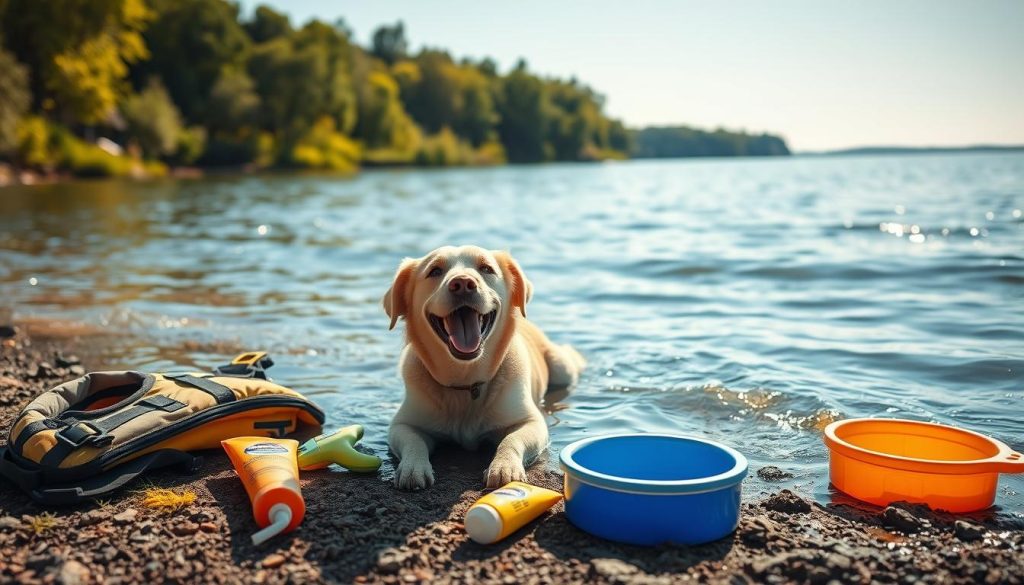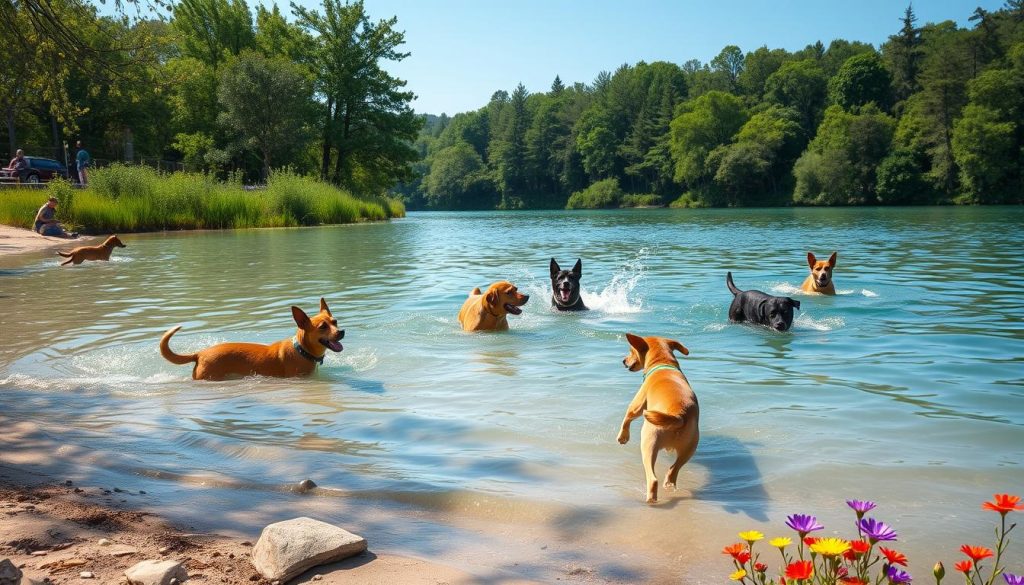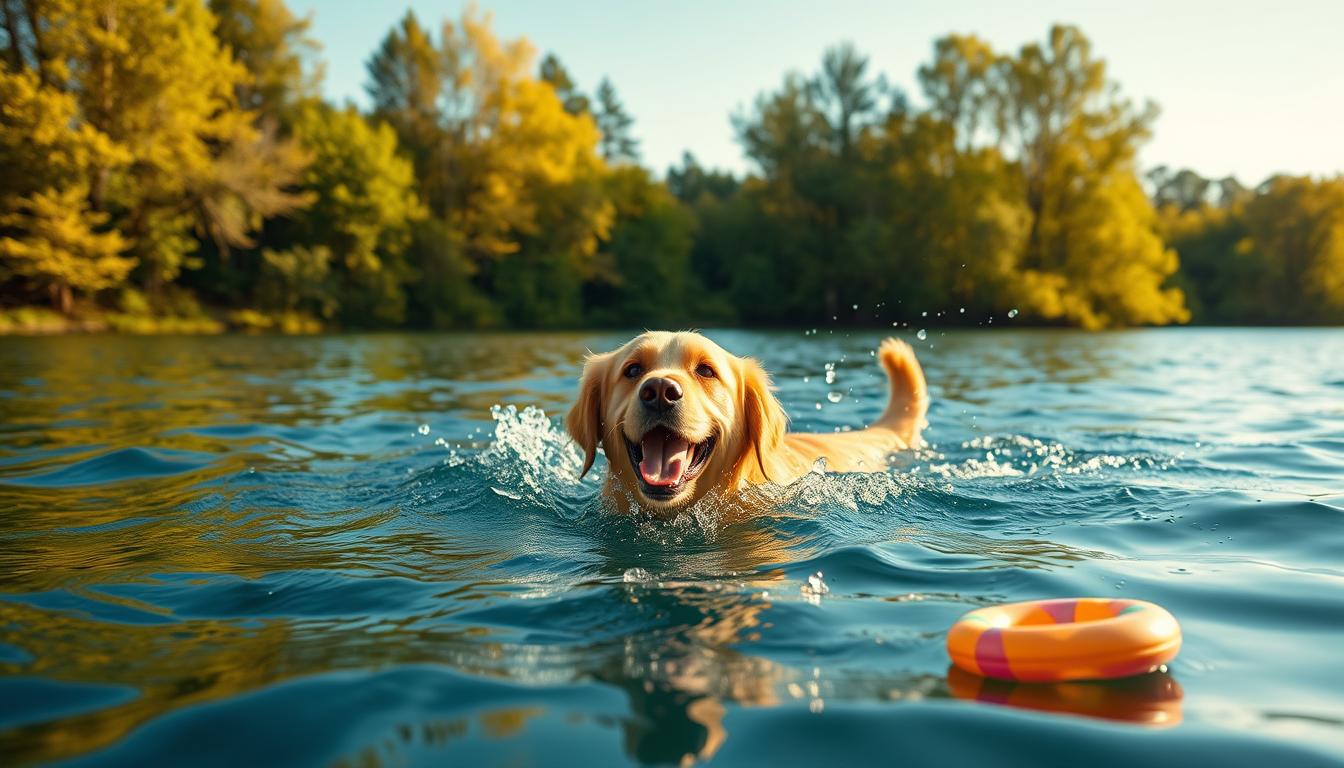As a devoted dog owner, I’m excited to share how to keep your furry friend safe in the water this summer. This guide offers essential tips and insights. They help you create unforgettable memories with your dog while keeping them safe and happy.
Planning a beach day, a pool party, or a lakeside adventure? Knowing about dog swimming safety is key. By understanding the risks and taking the right steps, you can make your pup’s experience fun and safe.
Understanding the Importance of Dog Swimming Safety
Keeping your dog safe while they play in the water is crucial. Unsupervised swimming can lead to drowning, hypothermia, and waterborne illnesses. As a dog lover, I want to highlight the need for dog water safety. We’ll look at the risks of unsupervised dog swimming and how to spot signs of distress in your pet.
Recognizing the Risks of Unsupervised Water Activities
Letting your dog swim without watching can be dangerous. They might get swept away by strong currents or tire and struggle to stay afloat. Cold water can also cause hypothermia, a serious health risk.
Waterborne illnesses are another worry. Stagnant or dirty water can have harmful bacteria and parasites. These can make your dog sick if they drink or touch the water. It’s especially important to watch out for this in new swimming spots.
Identifying Signs of Distress in Your Furry Companion
- Excessive panting or labored breathing
- Shivering or trembling
- Difficulty staying afloat or swimming
- Frantic paddling or attempts to climb out of the water
- Lack of responsiveness or lethargy
By watching for these signs of dog distress in water, you can act fast. This ensures your dog’s safety during water activities. Always put your dog’s well-being first when they’re in the water.

In the next section, we’ll talk about how to prepare for a safe and fun swim for your dog.
Dog Swimming Safety: Essential Preparations
Before you take your dog swimming, make sure they’re ready for a safe and fun time. Getting them prepared is key to a stress-free swim.
Start by slowly getting your dog used to the water. Let them get comfortable at their own pace. This helps them feel more confident and less anxious.
It’s also vital to watch your dog closely while they swim. Even if they’re good swimmers, never leave them alone. This way, you can spot any signs of trouble and help them right away.
Dog Swimming Safety Checklist
- Gradually introduce your dog to the water
- Ensure constant supervision when your dog is in the water
- Invest in a high-quality, properly-fitted life jacket
- Keep a close eye on your dog for signs of exhaustion or distress
- Familiarize yourself with dog swimming safety tips
Having the right safety gear, like a good life jacket, is important. It helps keep your dog safe and lets them enjoy the water more.
| Preparing for Dog Swimming | Dog Swimming Safety Tips |
|---|---|
|
|
By following these steps and tips, you can make sure your dog’s swim is safe and fun. Remember, good planning and watching closely are key to a great time in the water with your dog.

Dog-Friendly Water Spots: Finding the Perfect Aquatic Playground
Choosing the right spot for your dog’s water fun is key. We’ll look at how to find pet-friendly beaches, lakes, and water spots. It’s also important to think about water quality and hazards that could harm your dog.
Researching Pet-Friendly Beaches and Lakes
Not all beaches and lakes are safe for dogs. Start by checking local, state, and national parks. Many welcome dogs. Look for places marked as “dog-friendly” or with special swimming areas.
These spots usually have amenities like waste stations, fresh water, and shade. They make your dog’s visit more comfortable.
Considering Water Quality and Potential Hazards
After finding dog-friendly spots, check the water quality and hazards. Look for signs of pollution, algal blooms, or contaminants. These can make the water unsafe for your dog.
Also, watch out for strong currents, deep drop-offs, and other dangers. These could harm your dog.
| Water Quality Factors | Potential Hazards for Dogs |
|---|---|
| Bacteria levels | Strong currents |
| Algal blooms | Deep drop-offs |
| Chemical pollution | Sharp rocks or debris |
| Water temperature | Presence of wildlife (e.g., alligators, snakes) |

By carefully choosing dog-friendly water spots, you can keep your dog safe. You’ll also give them a fun and rewarding time in the water.
Equipping Your Pup for a Safe and Enjoyable Swim
Keeping your dog safe and comfortable in the water is key. The right swimming gear is crucial for their fun in the water. When picking a life jacket, look for a snug fit, enough buoyancy, and a strong handle for control.
Choosing the Right Life Jacket for Your Dog
Dog life jackets vary in size and design for different breeds. Consider your dog’s weight, chest size, and neck when choosing. Look for adjustable straps and bright colors or reflective strips for visibility.
Along with a good life jacket, think about other important swimming accessories. Non-slip booties protect their paws, and a floating leash lets you control them while they explore. With the right gear, your dog’s water adventures will be safe and fun.

